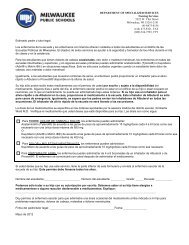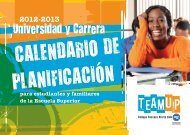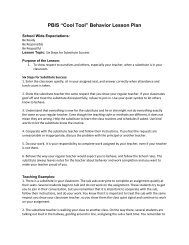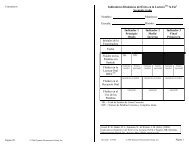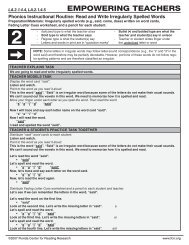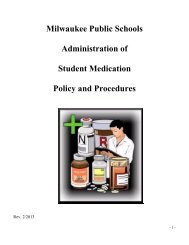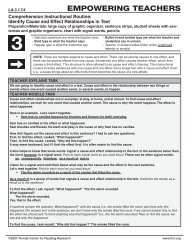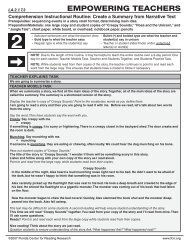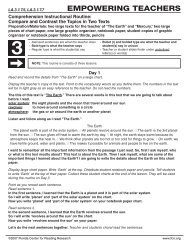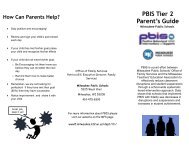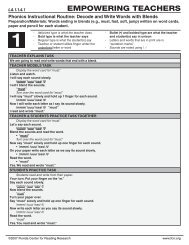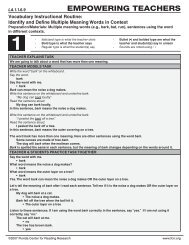Identify Cause and Effect Relationships in Text - Milwaukee Public ...
Identify Cause and Effect Relationships in Text - Milwaukee Public ...
Identify Cause and Effect Relationships in Text - Milwaukee Public ...
You also want an ePaper? Increase the reach of your titles
YUMPU automatically turns print PDFs into web optimized ePapers that Google loves.
LA.2.1.7.4<br />
EMPOWERING TEACHERS<br />
Benchmarks: Second Grade Comprehension:<br />
<strong>Identify</strong> <strong>Cause</strong> <strong>and</strong> <strong>Effect</strong> <strong>Relationships</strong> <strong>in</strong> <strong>Text</strong><br />
Preparation/Materials: large copy of graphic organizer, student sheets with sentences <strong>and</strong> graphic organizer,<br />
pencils, marker<br />
2<br />
-<br />
-<br />
-<br />
Italicized sentences are what the teacher does<br />
Bold type is what the teacher says<br />
Regular type is what the student(s) say<br />
-<br />
-<br />
Bullet (•) <strong>and</strong> bolded type are what the teacher <strong>and</strong><br />
student(s) say <strong>in</strong> unison<br />
Teacher or student slides f<strong>in</strong>der under underl<strong>in</strong>ed letter(s)<br />
or word(s)<br />
NOTE: There are multiple aspects to cause <strong>and</strong> effect. There can be several causes to one effect, <strong>and</strong><br />
there can be several effects from one cause. Sometimes one effect causes another effect which then<br />
causes a third effect. This structure is often referred to as cause <strong>and</strong> effect cha<strong>in</strong><strong>in</strong>g. This <strong>in</strong>structional<br />
rout<strong>in</strong>e focuses on just one cause <strong>and</strong> one effect.<br />
TEACHER EXPLAINS TASK<br />
We are go<strong>in</strong>g to learn about cause <strong>and</strong> effect. <strong>Cause</strong> <strong>and</strong> effect is the relationship between two th<strong>in</strong>gs or events<br />
where one event caused another event to happen.<br />
TEACHER MODELS TASK<br />
<strong>Cause</strong> <strong>and</strong> effect relationships occur everyday: at play, at home, <strong>and</strong> at school. To f<strong>in</strong>d cause <strong>and</strong> effect<br />
relationships, we look for one event that caused another event. The cause is why the event happens. The effect is<br />
what happened.<br />
Let’s look at two examples that have a cause <strong>and</strong> effect relationship.<br />
If the school bus is late, then Jamal misses breakfast at school.<br />
Miss<strong>in</strong>g breakfast is the effect or what happened. The late school bus is the cause.<br />
You feel cold, so you put on your sweater.<br />
Putt<strong>in</strong>g on your sweater is the effect or what happened. Feel<strong>in</strong>g cold is the cause.<br />
How did I figure out the cause <strong>and</strong> effect <strong>in</strong> these sentences I had to ask two questions.<br />
First, to f<strong>in</strong>d the effect, I asked, “What happened”<br />
Then, to f<strong>in</strong>d the cause, I asked, “Why did this happen”<br />
I am go<strong>in</strong>g to ask these two questions after read<strong>in</strong>g the next example.<br />
Maria was read<strong>in</strong>g a book <strong>and</strong> the ma<strong>in</strong> character was Peter. Peter ran faster than all the others, so he won the race.<br />
To f<strong>in</strong>d the effect, I ask myself, “What happened” Peter won the race.<br />
To f<strong>in</strong>d the cause, I ask myself, “Why did this happen” Peter ran faster than all the others.<br />
Display large graphic organizer. Po<strong>in</strong>t to each part as it is expla<strong>in</strong>ed.<br />
I’m go<strong>in</strong>g to write this <strong>in</strong>formation on a graphic organizer. I will write the cause on the left side of the chart under<br />
‘cause’. I will write the effect on the right side of the chart under ‘effect’.<br />
The question <strong>in</strong> the left box, ‘Why did this happen’ helps me f<strong>in</strong>d the cause.<br />
The question <strong>in</strong> the right box, ‘What happened’ helps me f<strong>in</strong>d the effect.<br />
I will write ‘Peter ran faster than all the others’ <strong>in</strong> the left box under cause.<br />
What do I write for the cause<br />
• Peter ran faster than all the others.<br />
I will write ‘he won the race’ <strong>in</strong> the right box under effect.<br />
What do I write for the effect<br />
• He won the race.<br />
Sometimes a sentence or paragraph can have more than one cause <strong>and</strong> more than one effect. Today we will learn<br />
about cause <strong>and</strong> effect relationships that have one cause <strong>and</strong> one effect.<br />
©2007 Florida Center for Read<strong>in</strong>g Research www.fcrr.org
EMPOWERING TEACHERS<br />
TEACHER AND STUDENTS PRACTICE TASK TASK TOGETHER<br />
To f<strong>in</strong>d cause <strong>and</strong> effect relationships, we look for one event that caused another event.<br />
The cause is why the event happens.<br />
What is the cause<br />
• Why the event happens.<br />
The effect is what happened.<br />
What is the effect<br />
• What happened.<br />
Distribute pencils <strong>and</strong> student sheets with sentences <strong>and</strong> the graphic organizer.<br />
F<strong>in</strong>d sentence #1. Let’s choral read, <strong>and</strong> then f<strong>in</strong>d the cause <strong>and</strong> effect relationship <strong>in</strong> this sentence. Ready<br />
#1 Susie was hungry so she ate her apple.<br />
To f<strong>in</strong>d the effect, we ask, “What happened”<br />
What do we ask to f<strong>in</strong>d the effect<br />
• What happened<br />
The effect is ‘Susie ate her apple’.<br />
What is the effect or what happened <strong>in</strong> this sentence<br />
• Susie ate her apple.<br />
Yes, that is the effect.<br />
If students answer the question, ‘What happened’ with the cause (i.e., she was hungry), ask them why this happened. The<br />
answer isn’t <strong>in</strong> the sentence; we don’t know why she was hungry. If we cannot answer this, to f<strong>in</strong>d the effect we should ask,<br />
“Is there anyth<strong>in</strong>g else that happened” (i.e., she ate her apple).<br />
To f<strong>in</strong>d the cause, we ask, “Why did this happen”<br />
What do we ask to f<strong>in</strong>d the cause<br />
• Why did this happen<br />
The cause is ‘Susie was hungry’.<br />
What is the cause or why did this happen <strong>in</strong> this sentence<br />
• Susie was hungry.<br />
Yes, that is the cause.<br />
Return to the large graphic organizer. Po<strong>in</strong>t to each part as it is expla<strong>in</strong>ed.<br />
We’re go<strong>in</strong>g to write this <strong>in</strong>formation on our graphic organizer under sentence #1.<br />
We will write the cause on the left side under ‘Why did this happen’<br />
Where do we write the cause<br />
• We write the cause on the left side under ‘Why did this happen’<br />
We will write the effect on the right side under ‘What happened’<br />
Where do we write the effect<br />
• We write the effect on the right side under ‘What happened’<br />
We will write ‘Susie was hungry’ <strong>in</strong> the left box under cause.<br />
What do we write for the cause<br />
• Susie was hungry.<br />
Write that on your graphic organizer <strong>and</strong> I will write on the large one.<br />
We will write ‘she ate her apple’ <strong>in</strong> the right box under effect.<br />
What do I write for the effect<br />
• She ate her apple.<br />
Now, you write on your graphic organizer <strong>and</strong> I will write on the large one.<br />
F<strong>in</strong>d sentence #2. Let’s choral read, <strong>and</strong> then f<strong>in</strong>d the cause <strong>and</strong> effect relationship <strong>in</strong> this sentence. Ready<br />
#2 The athlete was feel<strong>in</strong>g exhausted so he sat down on the grass to rest.<br />
To f<strong>in</strong>d the effect, we ask, “What happened”<br />
What do we ask to f<strong>in</strong>d the effect<br />
• What happened<br />
©2007 Florida Center for Read<strong>in</strong>g Research www.fcrr.org
TEACHER AND STUDENTS PRACTICE TASK TOGETHER (cont<strong>in</strong>ued)<br />
EMPOWERING TEACHERS<br />
The effect is ‘he sat down on the grass to rest’.<br />
What is the effect or what happened <strong>in</strong> this sentence<br />
• He sat down on the grass to rest.<br />
Yes, that is the effect.<br />
If students answer the question, ‘What happened’ with the cause (i.e., the athlete was feel<strong>in</strong>g exhausted), ask them why<br />
this happened. The sentence doesn’t tell us why. If we cannot answer this, to f<strong>in</strong>d the effect we should ask, “Is there anyth<strong>in</strong>g<br />
else that happened” (i.e., he sat down on the grass).<br />
To f<strong>in</strong>d the cause, we ask, “Why did this happen”<br />
What do we ask to f<strong>in</strong>d the cause<br />
• Why did this happen<br />
The cause is ‘the athlete was feel<strong>in</strong>g exhausted’.<br />
What is the cause or why did this happen <strong>in</strong> this sentence<br />
• The athlete was feel<strong>in</strong>g exhausted.<br />
Yes, that is the cause.<br />
We’re go<strong>in</strong>g to write this <strong>in</strong>formation on our graphic organizer under sentence #2.<br />
We will write ‘the athlete was feel<strong>in</strong>g exhausted’ <strong>in</strong> the left box under cause.<br />
What do we write for the cause<br />
• The athlete was feel<strong>in</strong>g exhausted.<br />
Write that on your graphic organizer <strong>and</strong> I will write on the large one.<br />
We will write ‘he sat down on the grass to rest’ <strong>in</strong> the right box under effect.<br />
What do I write for the effect<br />
• He sat down on the grass to rest.<br />
Now, you write on your graphic organizer <strong>and</strong> I will write on the large one.<br />
STUDENTS PRACTICE TASK<br />
Let’s review first. To f<strong>in</strong>d cause <strong>and</strong> effect relationships, we look for one event that caused another event.<br />
What is the cause<br />
The cause is why another event happens.<br />
What is the effect<br />
The effect is what happened.<br />
Yes. The cause tells us why an event happens <strong>and</strong> the effect tells us what happened.<br />
Let’s choral read sentence #3. Then you will f<strong>in</strong>d the cause <strong>and</strong> effect relationship. Ready<br />
#3 If Alex eats too much food, then he will ga<strong>in</strong> weight.<br />
What do you ask to f<strong>in</strong>d the effect<br />
What happened<br />
What is the effect or what happens <strong>in</strong> this sentence<br />
He will ga<strong>in</strong> weight.<br />
Yes, that is the effect.<br />
Aga<strong>in</strong>, if the students answer the question, ‘What happened’ with ‘he eats too much food’, ask them, “Why did this happen”<br />
The sentence doesn’t tell us why. If we cannot answer this, to f<strong>in</strong>d the effect we should ask, “Is there anyth<strong>in</strong>g else that<br />
happened” (i.e., he will ga<strong>in</strong> weight).<br />
What do we ask to f<strong>in</strong>d the cause<br />
Why did this happen<br />
What is the cause or why did this happen <strong>in</strong> this sentence<br />
Alex eats too much food.<br />
Yes, that is the cause.<br />
Write this <strong>in</strong>formation on your graphic organizer under sentence #3.<br />
What will you write <strong>in</strong> the left box under cause<br />
Alex eats too much food.<br />
©2007 Florida Center for Read<strong>in</strong>g Research www.fcrr.org
STUDENTS PRACTICE TASK (cont<strong>in</strong>ued)<br />
EMPOWERING TEACHERS<br />
Write ‘Alex eats too much food’ on your graphic organizer <strong>and</strong> I will write on the large one.<br />
What do you write <strong>in</strong> the right box under effect<br />
He will ga<strong>in</strong> weight.<br />
Yes, write ‘he will ga<strong>in</strong> weight’ on your graphic organizer <strong>and</strong> I will write on the large one.<br />
You’ve done a great job f<strong>in</strong>d<strong>in</strong>g cause <strong>and</strong> effect.<br />
Us<strong>in</strong>g cause <strong>and</strong> effect is one way that authors organize their writ<strong>in</strong>g to show the relationship between two th<strong>in</strong>gs<br />
or events. If we can recognize a sentence or paragraph that is organized around a cause <strong>and</strong> effect relationship,<br />
then we are able to better underst<strong>and</strong> the author’s message.<br />
INDEPENDENT PRACTICE<br />
When students consistently identify cause <strong>and</strong> effect relationships <strong>in</strong> a sentence or paragraph, provide opportunities to<br />
practice <strong>in</strong>dividually or <strong>in</strong> pairs us<strong>in</strong>g other explicit passages that have this structure.<br />
SCAFFOLDING SUGGESTION FOR ERRORS<br />
Verify that students are correctly identify<strong>in</strong>g how one event is the cause <strong>and</strong> another event is the effect. If students are<br />
experienc<strong>in</strong>g difficulty with this concept, use more examples from everyday experiences (e.g., I dropped the glass;<br />
therefore, the glass broke.). Echo read the sentences for students hav<strong>in</strong>g difficulty with the read<strong>in</strong>g level. If necessary<br />
dur<strong>in</strong>g student practice, prompt students by giv<strong>in</strong>g them the response before you ask them to state it. If students can’t<br />
answer questions about ‘what happened’, prompt them with the follow<strong>in</strong>g questions: Who or what is this sentence/<br />
paragraph about What is the most important th<strong>in</strong>g about the who or what If students answer the question about the<br />
effect by giv<strong>in</strong>g the cause, ask them why this happened or if this happened as a result of someth<strong>in</strong>g else. If students<br />
answer the question about the cause by giv<strong>in</strong>g the effect, ask them if this was the <strong>in</strong>itiat<strong>in</strong>g or start<strong>in</strong>g event that caused<br />
someth<strong>in</strong>g else to happen.<br />
Adaptations us<strong>in</strong>g this Instructional Rout<strong>in</strong>e:<br />
• Provide opportunities for students to write <strong>and</strong> illustrate cause <strong>and</strong> effect sentences.<br />
• Pair students, then give one student the beg<strong>in</strong>n<strong>in</strong>g of a sentence (the cause, e.g., It ra<strong>in</strong>ed all<br />
day) <strong>and</strong> have the other student f<strong>in</strong>ish the sentence with the effect (e.g., so the baseball game was cancelled, so the<br />
roads were flooded, or I couldn’t go swimm<strong>in</strong>g).<br />
• When students are secure with this rout<strong>in</strong>e, the teacher can give the students sentences where the effect is presented<br />
first <strong>and</strong> the cause is presented next.<br />
• When students are secure with f<strong>in</strong>d<strong>in</strong>g cause <strong>and</strong> effect with the questions <strong>in</strong> this rout<strong>in</strong>e, you can <strong>in</strong>troduce the idea<br />
that the effect is often the ma<strong>in</strong> idea.<br />
• When students are secure with f<strong>in</strong>d<strong>in</strong>g cause <strong>and</strong> effect relationships, you can give them sentences with more than<br />
one effect.<br />
For further <strong>in</strong>dependent practice with narrative text sequenc<strong>in</strong>g, refer to the follow<strong>in</strong>g Second <strong>and</strong> Third<br />
Grade FCRR Student Center Activities at http://www.fcrr.org/Curriculum/PDF/G2-3/2-3Comp_3.pdf<br />
• C.020<br />
©2007 Florida Center for Read<strong>in</strong>g Research www.fcrr.org
EMPOWERING TEACHERS<br />
1. Susie was hungry so she ate her apple.<br />
{ <strong>Cause</strong> }<br />
{ <strong>Effect</strong> }<br />
Why did this happen<br />
What happened<br />
2. The athlete was feel<strong>in</strong>g exhausted so he sat<br />
down <strong>in</strong> the grass to rest.<br />
{ <strong>Cause</strong> }<br />
{ <strong>Effect</strong> }<br />
Why did this happen<br />
What happened<br />
3. If Alex eats too much food, then he will ga<strong>in</strong><br />
weight.<br />
{ <strong>Cause</strong> }<br />
{ <strong>Effect</strong> }<br />
Why did this happen<br />
What happened<br />
©2007 Florida Center for Read<strong>in</strong>g Research www.fcrr.org
1.<br />
EMPOWERING TEACHERS<br />
{ <strong>Cause</strong> }<br />
Why did this happen<br />
{ <strong>Effect</strong> }<br />
What happened<br />
2.<br />
{ <strong>Cause</strong> }<br />
Why did this happen<br />
{ <strong>Effect</strong> }<br />
What happened<br />
3.<br />
{ <strong>Cause</strong> }<br />
Why did this happen<br />
{ <strong>Effect</strong> }<br />
What happened<br />
©2007 Florida Center for Read<strong>in</strong>g Research www.fcrr.org



